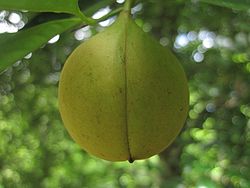 | |
| Names | |
|---|---|
| Preferred IUPAC name Tetradecanoic acid | |
| Other names C14:0 (Lipid numbers) | |
| Identifiers | |
3D model (JSmol) | |
| ChEBI | |
| ChEMBL | |
| ChemSpider | |
| ECHA InfoCard | 100.008.069 |
| EC Number |
|
PubChem CID | |
| RTECS number |
|
| UNII | |
CompTox Dashboard (EPA) | |
| |
| |
| Properties | |
| C14H28O2 | |
| Molar mass | 228.376 g·mol−1 |
| Appearance | colorless or white solid |
| Density | 1.03 g/cm3 (−3 °C) [2] 0.99 g/cm3 (24 °C) [3] 0.8622 g/cm3 (54 °C) [4] |
| Melting point | 54.4 °C (129.9 °F; 327.5 K) [5] |
| Boiling point | 326.2 °C (619.2 °F; 599.3 K) at 760 mmHg 250 °C (482 °F; 523 K) at 100 mmHg [4] 218.3 °C (424.9 °F; 491.4 K) at 32 mmHg [3] |
| 13 mg/L (0 °C) 20 mg/L (20 °C) 24 mg/L (30 °C) 33 mg/L (60 °C) [6] | |
| Solubility | Soluble in alcohol, acetates, C6H6, haloalkanes, phenyls, nitros [6] |
| Solubility in acetone | 2.75 g/100 g (0 °C) 15.9 g/100 g (20 °C) 42.5 g/100 g (30 °C) 149 g/100 g (40 °C) [6] |
| Solubility in benzene | 6.95 g/100 g (10 °C) 29.2 g/100 g (20 °C) 87.4 g/100 g (30 °C) 1.29 kg/100 g (50 °C) [6] |
| Solubility in methanol | 2.8 g/100 g (0 °C) 17.3 g/100 g (20 °C) 75 g/100 g (30 °C) 2.67 kg/100 g (50 °C) [6] |
| Solubility in ethyl acetate | 3.4 g/100 g (0 °C) 15.3 g/100 g (20 °C) 44.7 g/100 g (30 °C) 1.35 kg/100 g (40 °C) [6] |
| Solubility in toluene | 0.6 g/100 g (−10 °C) 3.2 g/100 g (0 °C) 30.4 g/100 g (20 °C) 1.35 kg/100 g (50 °C) [6] |
| log P | 6.1 [4] |
| Vapor pressure | 0.01 kPa (118 °C) 0.27 kPa (160 °C) [7] 1 kPa (186 °C) [4] |
| −176·10−6 cm3/mol | |
| Thermal conductivity | 0.159 W/m·K (70 °C) 0.151 W/m·K (100 °C) 0.138 W/m·K (160 °C) [8] |
Refractive index (nD) | 1.4723 (70 °C) [4] |
| Viscosity | 7.2161 cP (60 °C) 3.2173 cP (100 °C) 0.8525 cP (200 °C) 0.3164 cP (300 °C) [9] |
| Structure | |
| Monoclinic (−3 °C) [2] | |
| P21/c [2] | |
α = 90°, β = 94.432°, γ = 90° | |
| Thermochemistry | |
Heat capacity (C) | 432.01 J/mol·K [4] [7] |
Std enthalpy of formation (ΔfH⦵298) | −833.5 kJ/mol [4] [7] |
Std enthalpy of combustion (ΔcH⦵298) | 8675.9 kJ/mol [7] |
| Hazards | |
| GHS labelling: | |
 [10] [10] | |
| Warning | |
| H315 [10] | |
| NFPA 704 (fire diamond) | |
| Flash point | >110 °C (230 °F; 383 K) [11] |
| Lethal dose or concentration (LD, LC): | |
LD50 (median dose) | >10 g/kg (rats, oral) [11] |
| Related compounds | |
Related esters of myristic acid | Isopropyl myristate Phorbol myristate acetate Myristylbenzylmorphine Dimyristoylphosphatidylethanolamine |
Related compounds | Tridecanoic acid, Pentadecanoic acid |
Except where otherwise noted, data are given for materials in their standard state (at 25 °C [77 °F], 100 kPa). | |
Myristic acid (IUPAC name: tetradecanoic acid) is a common saturated fatty acid with the molecular formula CH3(CH2)12COOH. Its salts and esters are commonly referred to as myristates or tetradecanoates. The name of the acyl group derived from myristic acid is myristoyl or tetradecanoyl. The acid is named after the binomial name for nutmeg ( Myristica fragrans ), from which it was first isolated in 1841 by Lyon Playfair. [12]


